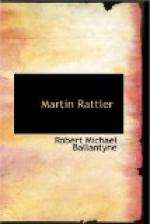The different kinds of soil through which it is necessary to cut before reaching the diamond deposit are, first, about twenty feet of reddish sandy soil; then about eight feet of a tough yellowish clay; beneath this lies a layer of coarse reddish sand, below which is the peculiar soil in which diamonds are found. It is called by the miners the cascalho, and consists of loose gravel, the pebbles of which are rounded and polished, having at some previous era been subject to the action of running water. The bed varies in thickness from one to four feet, and the pebbles are of various kinds; but when there are many of a species called Esmerilopreto, the cascalho is considered to be rich in diamonds.
Taking Martin round to the back of the shed, Barney showed him a row of troughs, about three feet square, close to the edge of a pond of water. These troughs are called bacos. In front of each stood a Negro slave up to his knees in water. Each had a wooden plate, with which he dashed water upon the rough cascalho as it was thrown into the trough by another slave. By this means, and by stirring it with a small hoe, the earth and sand are washed away. Two overseers were closely watching the process; for it is during this part of the operation that the largest diamonds are found. These overseers were seated on elevated seats, each being armed with a long leathern whip, to keep a sharp look out, for the slaves are expert thieves.
After the cascalho had been thus purified it was carefully removed to the shed to be finally washed.
Here seven slaves were seated on the side of a small canal, about four feet broad, with their legs in the water nearly up to their knees. The canal is called the lavadeira. Each man had a small wooden platter, into which another slave, who stood behind him, put a shovelful of purified cascalho. The bateia, or platter, was then filled with water and washed with the utmost care several times, being closely examined after each washing, and the diamonds picked out. Sometimes many platefuls were examined but nothing found; at other times several diamonds were found in one plate. While Martin was looking on with much curiosity and interest, one of the slaves uttered an exclamation and held up a minute stone between his finger and thumb.
“Ah! good luck to ye, lad!” said Barney, advancing and taking the diamond which had been discovered. “See here, Martin; there’s the thing, lad, that sparkles on the brow o’ beauty, and gives the Naygurs rheumatiz—”
“Not to mention their usefulness in providing the great Baron Fagoni with a livelihood,” added Martin, with a smile.
Barney laughed, and going up to the place where the two overseers were seated, dropped the precious gem into a plate of water placed between them for the purpose of receiving the diamonds as they were found.
“They git fifteen or twinty a day sometimes,” said Barney, as they retraced their steps to the cottage; “and I’ve hear’d o’ them getting stones worth many thousands o’ pounds; but the biggest they iver found since I corned here was not worth more than four hundred.”




